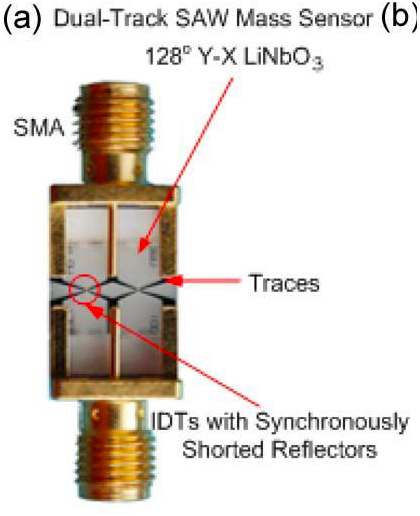Surface Acoustic Wave (SAW) devices are used in biosensors, gas, and chemical sensors because of their sensitivity to mass perturbations. SAW devices resonate and generate acoustic waves that are converted to electric signals, and vice versa, by the use of Interdigital Transducers or IDTs. The electric signals are then converted to mechanical energy by piezoelectric substrates.
SAW devices comprise of an input and an output transducer that convert acoustic waves generated by the SAW resonators to electric signals. During this process, a considerable loss in signal power or insertion loss (IL) may occur. So, to improve the performance of the SAW device as a resonance frequency (RF) filter and as a biosensor, it is necessary to lower the signal loss (>-3dB), and increase IL, quality factor (Q), and mass sensitivity.
The present invention describes a SAW device based on a Lithium Niobate (LiNbO3) piezoelectric substrate that exhibits the highest coupling between electrical and mechanical energy compared to all other varieties of substrates. Additionally, such a substrate also has the advantages of having a high velocity-shift coefficient and a high Electromechanical Coupling Coefficient, K2, which yields a higher IL and greater mass sensitivity in comparison with the same SAW device on any other piezoelectric substrates. Further, when the SAW-LiNbO3 device is used in a dual track format, it is more effective as a mass sensor because of its clear and repeatable frequency shifts. The device performanceis further improved with the use of reflectors. Because of the features of the device, it is suitable for detection of protein or peptides, macromolecular analytes, as well as microbial agents based on antigen-antibody other interactions.
Stage of Development:
- Prototypes of the SAW device have been made and tested in antigen-antibody detection assay
- Laboratory scale studies conducted

Fig. 1 - Dual-Track Surface Acoustic Wave (SAW) Mass Sensor
Applications:
- Sensors for use in biological, chemical, or physical applications
- Used as a mass sensor to sense an additional mass on the surface
- Used as a RF filter and in all RF tank circuits applications
Advantages:
- Maximum IL in the center frequency to read the signal
- No need of amplifiers or attenuators
- Smaller size compared to other varieties of SAW sensors
- High mass sensitivity and good linearity
- High Q factor